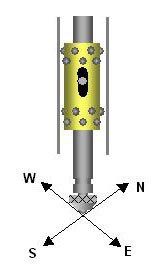It is relatively simple to determine good repeatability from a gauging probe by gently lifting the tip and allowing it to gently return to it's start position. A number of probe manufacturers use this method or fail to quote non repeat at all.
Unfortunately, apart from a few laboratory applications, such as Gauge Block Calibration, the vast majority of applications are a lot more demanding.
The method used to determine non-repeat at Solartron Metrology is very demanding but relative to both laboratory and shop floor applications.
A reading is taken with the probe tip resting on a datum point.
The tip is then raised while exerting a side force of 80-100 grm and returned to the start point. A second reading is taken to determine the deviation from the start point.
This process is repeated at the four points of the compass.
The maximum difference in the readings between the four lifting cycles represents non-repeatability.
